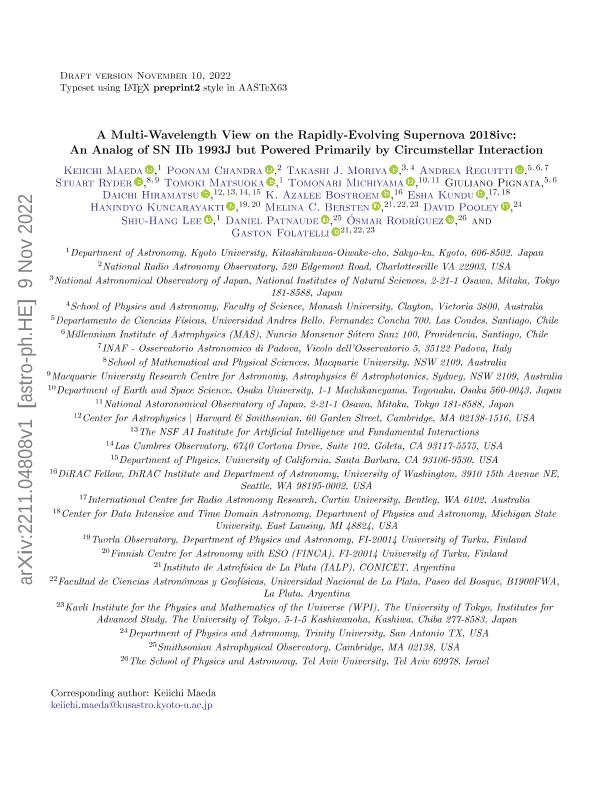Mostrar el registro sencillo del ítem
dc.contributor.author
Maeda, Keiichi
dc.contributor.author
Chandra, Poonam
dc.contributor.author
Moriya, Takashi J.
dc.contributor.author
Reguitti, Andrea
dc.contributor.author
Matsuoka, Tomoki
dc.contributor.author
Michiyama, Tomonari
dc.contributor.author
Pignata, Giuliano
dc.contributor.author
Hiramatsu, Daichi
dc.contributor.author
Azalee Bostroem, K.
dc.contributor.author
Kundu, Esha
dc.contributor.author
Kuncarayakti, Hanindyo
dc.contributor.author
Bersten, Melina Cecilia

dc.contributor.author
Pooley, David
dc.contributor.author
Lee, Shiu Hang
dc.contributor.author
Patnaude, Daniel
dc.contributor.author
Rodríguez, Ósmar

dc.contributor.author
Folatelli, Gaston

dc.date.available
2023-09-08T14:11:27Z
dc.date.issued
2022-12
dc.identifier.citation
Maeda, Keiichi; Chandra, Poonam; Moriya, Takashi J.; Reguitti, Andrea; Matsuoka, Tomoki; et al.; A Multiwavelength View of the Rapidly Evolving SN 2018ivc: An Analog of SN IIb 1993J but Powered Primarily by Circumstellar Interaction; IOP Publishing; Astrophysical Journal; 942; 1; 12-2022; 1-31
dc.identifier.issn
0004-637X
dc.identifier.uri
http://hdl.handle.net/11336/210934
dc.description.abstract
SN 2018ivc is an unusual Type II supernova (SN II). It is a variant of SNe IIL, which might represent a transitional case between SNe IIP with a massive H-rich envelope and SNe IIb with only a small amount of the H-rich envelope. However, SN 2018ivc shows an optical light-curve evolution more complicated than that of canonical SNe IIL. In this paper, we present the results of prompt follow-up observations of SN 2018ivc with the Atacama Large Millimeter/submillimeter Array. Its synchrotron emission is similar to that of SN IIb 1993J, suggesting that it is intrinsically an SN IIb-like explosion of an He star with a modest (∼0.5-1M ⊙) extended H-rich envelope. Its radio, optical, and X-ray light curves are explained primarily by the interaction between the SN ejecta and the circumstellar material (CSM); we thus suggest that it is a rare example (and the first involving the “canonical” SN IIb ejecta) for which the multiwavelength emission is powered mainly by the SN-CSM interaction. The inner CSM density, reflecting the progenitor activity in the final decade, is comparable to that of SN IIb 2013cu, which shows a flash spectral feature. The outer CSM density, and therefore the mass-loss rate in the final ∼200 yr, is higher than that of SN 1993J by a factor of ∼5. We suggest that SN 2018ivc represents a missing link between SNe IIP and SNe IIb/Ib/Ic in the binary evolution scenario.
dc.format
application/pdf
dc.language.iso
eng
dc.publisher
IOP Publishing

dc.rights
info:eu-repo/semantics/openAccess
dc.rights.uri
https://creativecommons.org/licenses/by-nc-sa/2.5/ar/
dc.subject
SUPERNOVAE
dc.subject
CIRCUMSTELLAR MATTER
dc.subject
Radio Sources
dc.subject.classification
Astronomía

dc.subject.classification
Ciencias Físicas

dc.subject.classification
CIENCIAS NATURALES Y EXACTAS

dc.title
A Multiwavelength View of the Rapidly Evolving SN 2018ivc: An Analog of SN IIb 1993J but Powered Primarily by Circumstellar Interaction
dc.type
info:eu-repo/semantics/article
dc.type
info:ar-repo/semantics/artículo
dc.type
info:eu-repo/semantics/publishedVersion
dc.date.updated
2023-09-05T18:03:29Z
dc.journal.volume
942
dc.journal.number
1
dc.journal.pagination
1-31
dc.journal.pais
Reino Unido

dc.journal.ciudad
Londres
dc.description.fil
Fil: Maeda, Keiichi. Kyoto University; Japón
dc.description.fil
Fil: Chandra, Poonam. National Radio Astronomy Observatory; Estados Unidos
dc.description.fil
Fil: Moriya, Takashi J.. Monash University; Australia
dc.description.fil
Fil: Reguitti, Andrea. Universidad Andrés Bello; Chile
dc.description.fil
Fil: Matsuoka, Tomoki. Kyoto University; Japón
dc.description.fil
Fil: Michiyama, Tomonari. Osaka University; China
dc.description.fil
Fil: Pignata, Giuliano. Universidad Andrés Bello; Chile
dc.description.fil
Fil: Hiramatsu, Daichi. Harvard-Smithsonian Center for Astrophysics; Estados Unidos
dc.description.fil
Fil: Azalee Bostroem, K.. The George Washington University; Estados Unidos
dc.description.fil
Fil: Kundu, Esha. Michigan State University; Estados Unidos
dc.description.fil
Fil: Kuncarayakti, Hanindyo. Turun Yliopisto; Finlandia
dc.description.fil
Fil: Bersten, Melina Cecilia. Consejo Nacional de Investigaciones Científicas y Técnicas. Centro Científico Tecnológico Conicet - La Plata. Instituto de Astrofísica La Plata. Universidad Nacional de La Plata. Facultad de Ciencias Astronómicas y Geofísicas. Instituto de Astrofísica La Plata; Argentina
dc.description.fil
Fil: Pooley, David. Trinity College; Estados Unidos
dc.description.fil
Fil: Lee, Shiu Hang. Kyoto University; Japón
dc.description.fil
Fil: Patnaude, Daniel. Harvard-Smithsonian Center for Astrophysics; Estados Unidos
dc.description.fil
Fil: Rodríguez, Ósmar. Universitat Tel Aviv; Israel
dc.description.fil
Fil: Folatelli, Gaston. Consejo Nacional de Investigaciones Científicas y Técnicas. Centro Científico Tecnológico Conicet - La Plata. Instituto de Astrofísica La Plata. Universidad Nacional de La Plata. Facultad de Ciencias Astronómicas y Geofísicas. Instituto de Astrofísica La Plata; Argentina
dc.journal.title
Astrophysical Journal

dc.relation.alternativeid
info:eu-repo/semantics/altIdentifier/url/https://iopscience.iop.org/article/10.3847/1538-4357/aca1b7
dc.relation.alternativeid
info:eu-repo/semantics/altIdentifier/doi/http://dx.doi.org/10.3847/1538-4357/aca1b7
Archivos asociados
